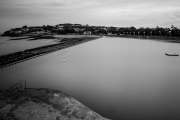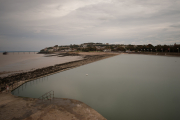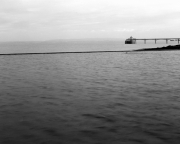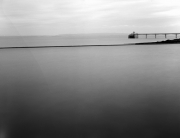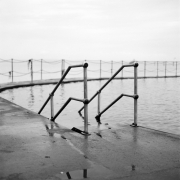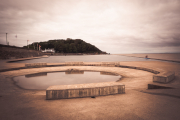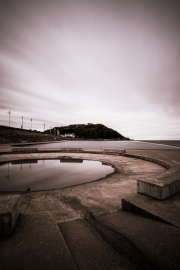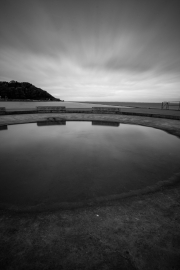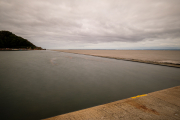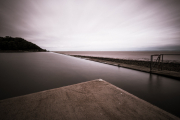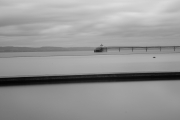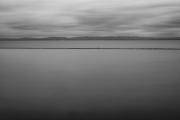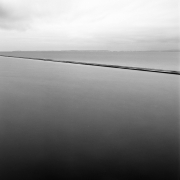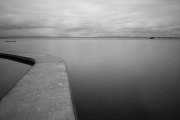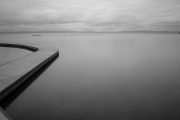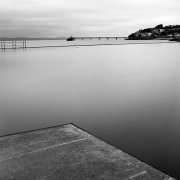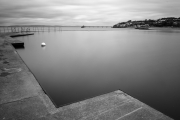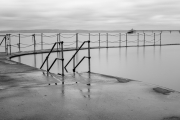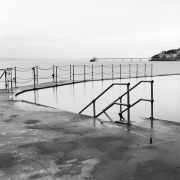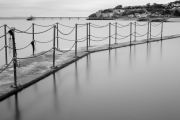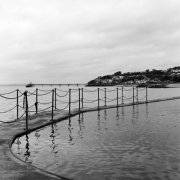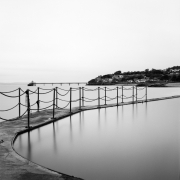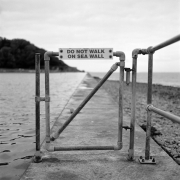The photos here are from two separate visits to photograph the seawater swimming lake in Clevedon, just a few days apart. I wasn’t happy with the results from the first visit, so actually went back and had another go.
We visited the lake last summer (see Clevedon & Portishead, June 2019), when I realised that it would be perfect for some long exposures – so having some time off work in September, I decided to give it a go. I specifically avoided a sunny day, as that wouldn’t work so well.
One other thing I had to do was make sure that the swimmers knew I wasn’t taking photos of them – it’s a public space so you can just pitch up and take photos. I made it clear to everyone that I wasn’t photographing them and was using long exposures – it actually made for a few conversations as people were interested in the film cameras and the technique.
The first set were taken on the Fuji digital (which turned out to really need the sensor cleaning), the Hasselblad (Lomo Potsdam B&W film) and the Intrepid 5×4 (Ilford Delta and Catlabs X 80 film). They were OK, but not great.
The two taken from high up just show the trail of a swimmer, which I rather like.
The two looking across the lake are from the large format camera – I really like the second, but there’s a developing/drying mark on the negative – which is so annoying.
The last one, of the steps, was taken on the Hasselblad and was a conscious effort to use it at f2.8 – and it really works. I love this one!
The second set were on the Fuji again (with a clean sensor) and the Hasselblad with Fuji Acros.
Given I wasn’t using the Intrepid, I was able to get through more shots, and was really pleased with the results. I was using the 10-stop ND filter to give me exposures up to 2 minutes, on the Fuji and the Hasselblad.
Fuji Acros has the advantage of excellent reciprocity characteristics, so the exposures don’t increase exponentially as they get longer, which makes it a lot easier to work with.
I’m really pleased with these, definitely the sort of thing I had in mind.
Perhaps one thing I would change is to take them at high tide, so the sea/Severn estuary is nearer to the level of the pool. At particularly high tides the waves actually come over the wall, which might be interesting.
To continue with large format or not?
The results from here are a major contributor to the doubts I’ve been having about continuing with the large format. It’s been an interesting experiment, but it’s a lot of work for results that haven’t really blown me away. I’ve taken about 250 shots with it now over the course of 4 years, and I’ve not got many crackers. Developing often seems to leave marks on the negs for some reason, and it’s all a bit dispiriting.
It’s also such an effort to shoot with it – it has its own backpack for the camera and slides, and I have to take a hefty tripod as well. So I’m always laden, and the amount of time it takes to take each shot means I can’t do everything I want to. Yes, I know large format photography is supposed to be slow, but I’m finding it a hinderance, it’s getting in the way of my photography.
And then there’s the Hasselblad, which I absolutely love. The quality is stunning, and I doubt there’s much I can do with the large format that I can’t do with the Hasselblad. I don’t use the large format camera movements, so what have I got other than a large negative?
